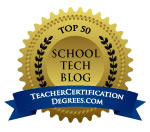 Beginning with the eSchool and eCampus News.
Beginning with the eSchool and eCampus News.
Explore flexible, affordable, and dependable interactive displays that are designed to work with the technology, software, and apps you use right now.
|
|
|
Educators must recognize the transformative potential of digital tools and AI in shaping the future of social studies education.
|
|
|
Moving on to the District Administration newsletters.
| TRENDING ON DA |
|
Nearly one-third of educators feel there are too many products to understand and use effectively, a new survey suggests. Here’s what teachers want instead.
Read more >> |
| Sponsored Content |
|
Sponsored by Stride Tutoring
In this 20-minute DA Ed Talk, the superintendent of the Pulaski County Public Schools (Va.) will discuss his district’s initiative to use high-dosage tutoring as an extension of classroom instruction, and how it is providing personalized support, complementing the work of teachers, and increasing learning outcomes.
View now >> |
Sponsored by FlexPoint Education Cloud®
In this DA Ed Talk, an experienced educator and curriculum developer will discuss three crucial planning steps that school and district leaders should take before beginning any digital curriculum search.
Register now >>
Similarly, the various editions from Education Week.
“We must remember that tech companies want different things for our children from what we do,” writes an English teacher.
|
| READ MORE |
|
Next, the Google News alert for virtual school.
CCCTC approves retirement of student services administrator – reviewonline.com
… virtual school students and at 7 p.m. May 22 for Crestview, United Local, Lisbon, and Wellsville students. The next meeting of the CCCTC Board of …
Online schooling is not just for lockdowns. Could it work for your child? | The New Daily
For example, Monash University has a free virtual school with revision sessions for Year 12 students. Some students preferred learning from home …
Inaugural Chess Tournament Awards Top 3 – WGNS Radio
Second place: Xavier Sztapka (Rutherford County Virtual School); Third place: Ben Chen (Central Magnet School). How Did This Chess Program Begin …
LaPorte Community Schools, Ind., to Launch Virtual Option – Government Technology
(TNS) — The LaPorte School Board approved on Monday the launch of a virtual school, as the district looks to bolster enrollment.
Opinion: Stop beating the dead [virtual] horse – The Battalion
… virtual school day. Though a good idea on paper, the execution of New York’s plan proved problematic — over a million students and teachers weren …
Bill Aiming To Limit Virtual School Days Passes Out Of Senate
Bill Aiming To Limit Virtual School Days Passes Out Of Senate. The bill … Virtual School Days Passes Out Of Senate. April 15th, 2024.
Ty Babinski: Legislature gets an incomplete – WisPolitics
This past legislative session saw several meaningful initiatives falter. So the Wisconsin Coalition for Virtual School Families, which I lead, will be …
Rutherford Co. Property Assessor Talks Chess in Schools, First Tournament
Xavier Sztapka (Rutherford County Virtual School) and Ben Chen (Central Magnet School) finished second and third place, respectively. Other …
Western announces spring honorary degree recipients
… virtual school in the U.S. The pair are being honoured for ensuring all students have access to quality education and are empowered to take …
Franklin Schools offer virtual option next school year | Local News Digital
FRANKLIN, Ind. – Franklin Community Schools (FCS) announced Monday that it is introducing Franklin Community Virtual School (FCVS) this fall.
Ann Arbor schools refused to save money. Now layoffs are coming. – Detroit Free Press
And the federal relief dollars used to fill the salaries and benefits for certain positions like “virtual school principal” have dried up. Now …
Enrollment for summer school in Detroit begins next month. Here are some details. – Chalkbeat
Golightly Education Center, 8 a.m. to 3:30 p.m., for students from Golightly, Burton, Virtual School, Spain; Gompers Elementary-Middle School, 8 …
Virtual School Advisory Teacher (Children with a Social Worker) – Local Gov Jobs
Virtual School Advisory Teacher (Children with a Social Worker) job in Wandsworth, London with London Borough of Richmond upon Thames and London …
US News ranked the nation’s high schools. Two Brevard schools made the top 100 – Florida Today
Brevard Virtual School — 445 in Florida, 9,844 in nation; Cocoa High School — 509 in Florida, 12,310 in nation; Rockledge High School — 522 in …
US News ranked the nation’s high schools. Two Brevard schools made the top 100 – Yahoo
Brevard Virtual School — 445 in Florida, 9,844 in nation. Cocoa High School — 509 in Florida, 12,310 in nation. Rockledge High School — 522 in …
From O’Gorman to Air Force, military intelligence leader builds on strong high school foundation
Why I mentor: Woman helps support student through virtual school. Jan 26, 2021. School news of the week: Welcoming class of 2035, ‘book tasting’. Mar …
Victory Early College High School, Blanson CTE, and Carver HS Rank Among Best in … – Aldine ISD
Virtual School · College Partners · ScholarshipsApply · Schoology · ClassLink. General. Back to School · Student Code of Conduct · Student/Parent …
Special-Called BOE Meeting – Knox County Schools
Knox County Virtual School (hs) (es) (ms) · West Haven Elementary School (es) · West High School (hs) · West Hills Elementary School (es) · West …
Mixed reactions to MCPS’ asynchronous learning day | MoCo360
The day also led to frustration for some parents and challenges for students that reminded them of virtual school during the COVID-19 pandemic.
Room scans & eye detectors: Robocops are watching your kids take online exams
[Related: Virtual school enrollment kept climbing even as COVID receded]. Proctorio did not respond to multiple requests for comment by The 74 …
Senate of Canada – At a glance
… virtual school visit … Thursday, March 21, 2024 – Senator Marilou McPhedran, right screen, second from left, and Shoshana Iny; virtual school …
Arkansas School for the Blind and Arkansas School for the Deaf voted to name Nicole Walsh …
Walsh has worked as the Exceptional Student Education coordinator for deaf/hard of hearing and visual impairment for the Florida Virtual School K …
2 Palm Beach County high schools ranked top 100 in country by US News & World Report
“During the COVID time, she took all the online courses, virtual school to get there and finally go there, and I’m very proud of that and Suncoast is …
Virtual Classroom Market on a Rapid Climb Driven by Soaring Demand for Flexible …
… Virtual School Victoria, now the largest school in the state with over 5,500 students enrolled in primary and secondary education, exemplifies …
Gov. Sanders, Secretary Oliva Announce Nicole Walsh as Superintendent for School for the Deaf
… Virtual School K-12. In that role, she coordinates services and evaluations for deaf/hard of hearing and visually impaired students statewide to …
Past fashion brands make a comeback before and after the COVID-19 pandemic
Trends changed to comfortable looks including leggings, knitted pants and sweatsuit sets. For virtual school and work, elevated comfort was the key to …
RCS announces 2023-2024 Teachers of the Year – Rutherford County Schools
Justin Whaley – Plainview Elementary; Amy Penny – RCS Virtual School; Ernest Rivas – Riverdale High; Andrea Martz – Rock Springs Elementary; Rachel …
Missouri lawmakers continue pushing forward – Daily Journal Online
Initially focused on refining Missouri’s Course Access and Virtual School Program, HB 2287 calculates average daily attendance for full-time …
BCPS 2023 Federal Graduation Rate On the Rise and Exceeds State Average
Six District high schools earned 100% graduation rates: Atlantic Technical High School, Broward Virtual School, College Academy at Broward College …
Competitive salaries remain a goal for BHCSD#2 – Lovell Chronicle
“In brick-and-mortar students, between Rocky and Burlington, they have less kids on-site than we do; they just have the 500 in virtual school.
BCPS 2022 Federal Graduation Rate Exceeds Pre-Pandemic Rates – Broward Schools
Six District high schools earned 100% graduation rates: Broward Virtual School, College Academy at Broward College, Lauderhill 6-12, Millennium 6-12 …
Bill forcing sellers to clearly mark seafood origin advances House committee
Virtual school’s board votes against full in-person work week. June 15, 2022 0 · Ascension arrests, terminates deputy for punching combative arrestee …
Who Is Xavier Worthy’s Mother? Everything You Need To Know About Nicky Jones
… Virtual School). As a result, he finished his high school diploma a year ahead of time. “I did some asking around, and someone recommended ALVS …
Families plead with Brockton not to close virtual school – Enterprise News
When was Brockton Virtual Learning Academy created? Administrators considered creating a virtual school as far back as 2019, but BVLA first opened in …
John I. Leonard High Hosts Another Successful International Spanish Academy Symposium
Virtual School, Palm Beach · Voluntary Prekindergarten (VPK) Programs · Volunteer in Our Schools · Welcome Center · Back to School · Parent How-To …
Pearson 2024 Q1 Trading Update – Company Announcement – FT.com – Markets data
We will be opening another virtual school in Missouri, in addition to those previously announced as secured in Pennsylvania and California. We are …
Building culture: SPS superintendent reflects on years in Stillwater | News | ocolly.com
As the superintendent of Stillwater Public Schools, Gordon is in charge of overseeing six elementary schools, one virtual school, one alternative …
Local high school graduations set for May 16-21 – Lehigh Acres Citizen
• 7 p.m., Lee Virtual School, South Fort Myers High School Auditorium. Sunday, May 19. • 10 a.m. North Fort Myers High School, Alico Arena. • 2:30 …
In Seminole County, a Black community will finally get a promised community center – Yahoo
Families plead with Brockton not to close virtual school — only school some have known. 6h ago. KLAS articles. Fight between high school substitute …
UNI to offer online MBA degree | Education | kwwl.com
Dubuque Community School District will offer fully virtual school in fall of 2022. Updated Apr 6, 2022. Local Teamsters Union endorses Cedar Rapids …
Which Lexington middle school principal is moving to another school? – AOL.com
Families plead with Brockton not to close virtual school — only school some have known … BROCKTON — Fred Bond is a fourth-grade student at the …
Arts Will Come Alive During 2024 Student Art Showcase – West Virginia Department of Education
West Virginia Virtual School · Educators · Families · Data Management & Information Systems · Data Analysis & Research · Data Analysis · Education …
Finally, the Google News alert for cyber school.
Pl. Valley adds role for cyber principal – Times News
On Thursday night, human resources director Lori Fulmer said Van Voorhis is still going to be the principal of the cyber school, but now he is adding …
School board discusses learning management system | News | dailycourier.com
… cyber school within the district. She said the district’s grant originally dealt with cyber school and was written because of Schoology. “So one …
Startups and scaleups to know about in Bristol & Bath cyber – techSPARK
… cyber school. James recognised that passive, classroom-based training could not keep pace with threats. He realised an agile, hands-on, solution …
Brockway Area School Board hires new boys basketball coach – The Courier Express
Brockway is also connecting with Titusville Area School District for cyber school services at a cost of $3,710 per regular education student, $5,710 …
Police Chief: Oswayo Valley superintendent allegedly locked down school over false allegations
… cyber school saying his girlfriend’s son was being withdrawn from a cyber school after they had been contacted by Hamberger. The superintendent …
Establishing Budgets as the School Year Comes to a Close – Chambersburg School Board …
… cyber school reforms in the tuition. He went on to assert that both “would benefit the Chambersburg School District tremendously with significant …
Letter: Response to CCA claims – The Sentinel
Better questions are why so many parents return their students to their community schools after a few years in a cyber school – and why CCA …
A-C Valley board discusses possible tax increase | Frontpage – The Clarion News
… cyber school unassigned fund balances, require wellness checks of students to ensure their well-being and their cyber school participation …
New Bethlehem Fire Company welcomes newest junior member – The Courier Express
Gould, a high school student at PA Cyber School, brings a passion for community service and a family legacy of firefighting to her role. Gould …
Cyber Charter School Reform Links to Larger School Choice Debates in Harrisburg – Erie News Now
“Why are there different numbers for the same student in the same cyber school? Finding a balance there makes sense.” Democrats say cyber schools …
The glitch in Japan’s plans to bolster U.S. defense
… cyber school. | Jiji. By Kaori Kaneko, Tim Kelly and John Geddie Reuters. SHARE. Twitter Facebook LinkedIn Email Print. Apr 26, 2024. As the United …
Two Gibraltar CyberCenturion teams advance to grand finals
Teams have been attending weekly classes led by Jared Cruz since September 2023 with some members having participated in Cyber School for the past six …
.







 Beginning with the eSchool and eCampus News.
Beginning with the eSchool and eCampus News.











 12 Unique Blogs Are Written By Professors
12 Unique Blogs Are Written By Professors